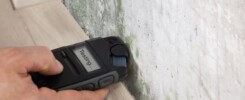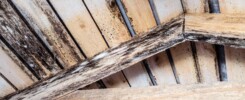One man suffered an asthma attack and ended up in a medically induced coma in the hospital. All from toxic black mold exposure. Sadly, this outcome was entirely preventable if the mold had been removed.
Protect your family by looking for mold in and around your home. Being able to identify mold colors can help you find mold in your home. You can then act quickly to remove it.
A Note on Mold Colors
You cannot tell what type of mold you have solely based on looking at the color. Many molds will have several colors throughout. They could even reflect one color on this list but then be another when tested.
Knowing the color of the mold you have should signal that you need to have a professional test, identify, and remove the mold from your home.
Black Mold
The first one on this list is the most dangerous. Black mold exposure can create severe health problems for those exposed. It is a highly toxic mold with a slimy texture.
You cannot tell that mold is the dreaded “black mold” just by looking at it. Black mold can vary in color from pure black to greenish. You need to have it tested to confirm that you have the toxic black mold everyone fears.
Pink Mold
Another highly toxic mold is the pink variety. It’s most commonly found in bathrooms and kitchens, where moisture hits high levels for sustained periods. What makes this mold so dangerous is its spore release.
These spores get airborne and then breathed in. When this happens, you can develop serious health problems. Dangerous pink mold usually has a slimy texture.
Sometimes, you will see a pink mold growing on your bathroom surfaces. There is a harmless type of mold that loves soap scum. You can use household cleaning products to remove it.
Green Mold
Green mold can come in a wide variety of shades, making it challenging to identify. You can’t do it on color alone and must have it tested by a professional. For example, a greenish-black mold could actually be toxic black mold.
Or there is the olive green mold that could have shades of brown and grey in it. It has a powdery texture that releases spores. It is dangerous, as it can cause a brain infection called fungal meningitis.
Then, there is the harmless green mold that you can clean yourself.
White Mold
The most common type of mold is white. It can grow anywhere and often gets mistaken for mildew. Many people find it challenging to spot white mold because it grows in spots from microscopic spores.
It spreads well across organic materials like wood, drywall, fabric, or plants. White mold typically looks like a film covering the surface of something. Or it can look flaky or powdery.
Purple Mold
You will typically find purple mold around spoiled food, making it common to see it in the kitchen or anywhere food is stored. However, it can sometimes appear on fabrics, such as stored clothing or furniture.
While purple mold is not toxic, it can aggravate some people’s allergies.
Identifying it can be tricky, as the color can range from pale lavender to a dark plumb. It will typically have an earthy or musty smell. The texture will have a soft, fuzzy look.
Grey Mold
Grey mold typically grows in basements and attics. As Florida homes don’t have basements, you may find it growing in your garage. It likes humid environments that don’t get a lot of sunlight.
High humidity or water leaks create the perfect environment. You will want professionals to remove it, as it can cause respiratory issues, headaches, and sore throats. However, it can be deadly for your houseplants.
Orange Mold
If you find orange mold in your home, avoid it altogether. Immediately call a professional to have it removed. Some orange mold is harmless, and others are highly toxic.
Don’t take the risk of what type you have. It’s best to have a professional come in and test the mold.
However, orange mold typically grows in nature because it likes to grow on wood. You will likely find it growing on wood surfaces in and around your home.
Yellow Mold
Generally, yellow mold is not considered a toxic variety. It’s another common food mold, usually growing on bread or cheese. It can cause some people’s allergies to flare up.
However, some types produce mycotoxins. These are toxins that can cause health problems.
If you have yellow mold in your home, it’s best to have a professional remove it. Removal can get tricky, so enlisting a professional’s help ensures you remove all of it. Otherwise, you risk it quickly spreading and becoming out of control.
Red Mold
You will typically find red mold in your bathroom due to the high moisture. It could be on towels or clothing left in the bathroom. Red mold is almost always harmless and easily removed, so you can take care of it with household cleaning products.
While it is called red, it can vary significantly in color. When in doubt, have a professional identify your mold.
Brown Mold
Brown mold can appear on almost any surface, from old food to humid environments. When on smooth surfaces, it can spread rapidly. It commonly causes respiratory irritation or allergy problems in humans.
Brown mold is one of the biggest culprits for creating a musty smell in your home.
Get Expert Advice for Your Mold Colors
You can’t definitively identify different types of mold by their color. However, knowing your mold colors will help you see the severity of the situation and the best removal method. Some molds are relatively harmless, and you can clean them with products you have at home.
Other molds are hazardous, with high levels of toxicity. The best approach for dealing with these molds is to hire a professional removal service like Big Easy Restoration. Our experienced team can help you identify the mold plaguing your home and provide solutions for removing it.
Protect your family from mold by having the experts come to your home to remove it.


